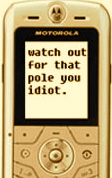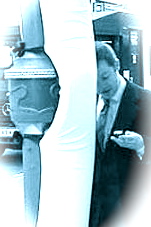 . . a friendly warning from Geekologie . .
. . a friendly warning from Geekologie . . 
nice
bumping into you — a bit
of sarcasm in her voice.. by dagosan
 The Darwin Awards are famous for humorous anecdotes about people who help improve our species by “culling the herd” — “accidentally removing themselves from it!” The dangers of driving while texting are obvious and many of its practitioners are culling themselves — along with innocent victims — from our herd (often leaving a trail of heartache behind for loves ones). But, there has been a rash of stories lately about similar hazardous behavior known as “texting while walking” — and its deadly cousin, “texting while crossing” [the street].
The Darwin Awards are famous for humorous anecdotes about people who help improve our species by “culling the herd” — “accidentally removing themselves from it!” The dangers of driving while texting are obvious and many of its practitioners are culling themselves — along with innocent victims — from our herd (often leaving a trail of heartache behind for loves ones). But, there has been a rash of stories lately about similar hazardous behavior known as “texting while walking” — and its deadly cousin, “texting while crossing” [the street].
“Not much of a problem,” you say?
Well, not according to the American College of Emergency Physicians (ACEP). An recent Injury Prevention message entitled “Text Messaging: Emergency Physicians Express Safety Concerns As Kids Go Back To School” urged “Plain old common sense” — don’t text while walking, driving, rollerblading. The ACEP advisory reported that:
“[T]he nation’s emergency physicians say they are seeing a dangerous trend that can go hand-in-hand with texting: a rise in injuries and deaths related to sending text messages at inappropriate times, such as while walking, driving, biking or rollerblading. . . .
“People are texting and they trip and fall on their faces – usually people in their 20s. We see a lot of face, chin, mouth [and] eye injuries from falls.”
As a Milwaukee Journal Sentinel reporter quipped over the weekend,”Think texting is tough on your thumbs? It could be a lot harder on your face.” (“A new hazard: texting while walking,” Aug. 9, 2008)
“Even worse . . . are the injuries that result from people texting and causing collisions with bikers, rollerbladers and others.”
Naturally, Old Fools are also at risk and at fault due to risky text-walking behavior:
“Dr. Paul Walsh, an emergency physician in Bakersfield, Calif., reported treating a man in his 50s who was talking on the phone to his wife. ‘He was distracted and was killed as he crossed the road’.”
 Dr. Linda Lawrence, President of ACEP, advises the following common-sense safety measures, among others:
Dr. Linda Lawrence, President of ACEP, advises the following common-sense safety measures, among others:
* Don’t text or use a cell phone while engaged in any physical activities that require sustained attention; such activities include walking, biking, boating, rollerblading or even intermittent-contact sports such as baseball, football or soccer. * Never text or use a hand-held cell phone while driving or motorcycling, and use caution even with headsets.
* Ignore the call or message if it might interfere with concentration during critical activities that require attention. Better yet, turn off the device beforehand . . .
* Be mindful of the distraction and corresponding reflex-response delay that texting can cause, and don’t text in any environments in which excessive inattention can cause safety concerns, such as while sitting alone at night, waiting for a bus, or in a crowded area, where one could easily become a victim of a personal theft.

![]() .. devolution?
.. devolution?
For more on the ACEP Texting-Walking Warning, see: “Texting hazardous while walking” (UPI, Aug. 9, 2008, where emergency physician
“I think they just get so focused on (texting) they don’t see a little bump or a trip or a stumble, and down they go. And they’re not in a position to brace themselves.”
And, listen to “Texting While Walking May Be Dangerous” (npr, All Things Considered, July 31, 2008; 4-minute audio clip)
Medical warnings are not, however, the whole story.
For example:
- Padded Poles: Some street poles in London have been padded like soccer goals, to help prevent injuries to text-walkers. See a You Tube Video; and coverage at Geekologie (including a video clip of a non-observant tv reporter)
 Legislative Solutions? To the dismay of the “this is a free country” crowd, law-makers in at least two states have proposed banning the use of Blackberries, ipods, cellphones, and similar devices while crossing the street. In the lengthy article “R U ambu-textrous?“(July 29, 2008) Chicago Tribune reporter Louis Carlozo tells about the rash of injuries and accidents involving texting walkers, as an introduction to discussing “a new bill that would ban using a wireless device while crossing streets.” The proposal — an Illinois General Assembly bill known as HB 4520 — is being considered by officials such as state Illinois Secretary of State Jesse White, and was introduced last January by Rep. Ken Dunkin (D- Chicago).
Legislative Solutions? To the dismay of the “this is a free country” crowd, law-makers in at least two states have proposed banning the use of Blackberries, ipods, cellphones, and similar devices while crossing the street. In the lengthy article “R U ambu-textrous?“(July 29, 2008) Chicago Tribune reporter Louis Carlozo tells about the rash of injuries and accidents involving texting walkers, as an introduction to discussing “a new bill that would ban using a wireless device while crossing streets.” The proposal — an Illinois General Assembly bill known as HB 4520 — is being considered by officials such as state Illinois Secretary of State Jesse White, and was introduced last January by Rep. Ken Dunkin (D- Chicago).
“This legislation is not laughable. On the surface it’s like, ‘Oh wow, what is this?’ But it’s becoming more and more of a common problem with people haplessly crossing an intersection and almost killing themselves.”
– Hot Air has a FoxNews clip interview with Shepherd Smith berating Rep. Dunkin for his protectionist proposal.
The Tribune piece says that “Under the proposed law, Illinois residents would get slapped with a misdemeanor and a $25 fine if caught using a cell phone or other wireless device while traversing streets.” And, it advises, “Even as lawmakers take a closer look at the issue, texters might want to scrutinize their own abilities to divide their attention in so many directions.” Thus,
“The brain’s ability to take on several activities at once makes text-walking possible, researchers say, but it’s a delicate balancing act. All it takes is one unexpected disruption to turn a text-walk into a garble-stumble.”
- Text-walking involves mastering two independent skills. With the walking part, balance and posture, as involuntary actions, are controlled by the cerebellum.
- “The brain gets input from many areas: sight, listening, touch,” Wellisch said. “Your feet are sensing whether you are going up a or down a hill. As you go from a child to an adult, you integrate more functions into it.”
- To stroll and string keystrokes, the brain creates feedback between the dorsolateral frontal cortex (concerned with planning, strategizing and sequencing) and the parietal lobe (which integrates sensory information).
 Not surprising: “Not that many people seem aware” of how complicated and delicate this process is. In response, new-student orientation at the University of Illinois at Urbana-Champaign now include cautionary words from campus police about the perils of ped-texting, with the message “Walk defensively.”
Not surprising: “Not that many people seem aware” of how complicated and delicate this process is. In response, new-student orientation at the University of Illinois at Urbana-Champaign now include cautionary words from campus police about the perils of ped-texting, with the message “Walk defensively.”
In Chicago, the Lake Shore path is “ground zero” of the texting-while-walking problem, where distracted pedestrians can “pose as much of a threat as they themselves might be threatened.” People want to multi-task and disengage from the world, but they’re doing it in places where their own safety and that of others requires that they be connected to their surroundings “at all times, and respond to them immediately.”
The article goes on to say that the “Rules are evolving” about when and where it is appropriate to be texting — and exposing others to the risks caused by one’s multitasking juggling act.
For more, see “omg! A Ban on Using Cell Phones While Walking?” (Bob’s Government Info Weblog, July 31, 2008), and check out WNBC.com’s description, posted Feb. 6, 2007, of a similar proposal by a New York state senator from Brooklyn, Sen. Carl Kruger, which would “ban people from using an MP3 player, cell phone, Blackberry or any other electronic device while crossing the street in New York City and Buffalo.” Its online survey results are heavily against the proposal, but Nicole Lake of Jersey City told the reporter:
“It’s too dangerous. Drivers don’t pay attention and pedestrians don’t pay attention.”
 Finally, NYT City Life columnist Verlyn Klinkenborg muses over the problem in “The Smart-Phone Attitude” (New York Times, August 10, 2008), noting that devices like the iPhone are “more computer than phone,” making their use while walking even more problematic than mere perambulatory phoning. He points out that “According to one estimate, there will be five billion people using mobile phones by 2011, which means that, for some part of each day, most of our species will be reduced to wandering aimlessly.” From his perch at an outdoor restaurant “in a neighborhood with high smart-phone density,” Klinkenborg saw this scene:
Finally, NYT City Life columnist Verlyn Klinkenborg muses over the problem in “The Smart-Phone Attitude” (New York Times, August 10, 2008), noting that devices like the iPhone are “more computer than phone,” making their use while walking even more problematic than mere perambulatory phoning. He points out that “According to one estimate, there will be five billion people using mobile phones by 2011, which means that, for some part of each day, most of our species will be reduced to wandering aimlessly.” From his perch at an outdoor restaurant “in a neighborhood with high smart-phone density,” Klinkenborg saw this scene:
“Watching the passers-by holding their smart phones in front of them as they walked was like watching a parade of monks with heads bowed over their breviaries. As night settled in, I could see the glow of the screens shining upward on the faces of their owners, who were being guided down the street by peripheral vision and the feel of the sidewalk under their feet. It was like being in one of R. Crumb’s street scenes — everyone lost in a private thought bubble, everyone walking with a private posture.”
Long ago disabused of the vain notion that “talking on a cellphone had no effect on my walking pace or directional stability,” Klinkenborg counsels:
“And after switching to a smart phone, I had to switch to a new way of walking. . . . So when my pocket pulses, I duck into a doorway or line myself up behind a lamppost, out of the current like a trout behind a rock. I feel at times like a remote-controlled robot, but I honor the first law of New York: keep moving or get out of the way.”
 If it didn’t put others at risk, Prof. Yabut and the rest of the f/k/a Gang would just let the ped-texters continue to bang their heads on light poles and their chins on sidewalks. However, in a society where a shocking percentage of people are oblivious or indifferent to the risks their multi-tasking is causing for others (can you say Driving While Phoning?), passing laws to curb these devices is definitely an attractive option.
If it didn’t put others at risk, Prof. Yabut and the rest of the f/k/a Gang would just let the ped-texters continue to bang their heads on light poles and their chins on sidewalks. However, in a society where a shocking percentage of people are oblivious or indifferent to the risks their multi-tasking is causing for others (can you say Driving While Phoning?), passing laws to curb these devices is definitely an attractive option.
wild berries –
one training wheel
lifts round the curve.. by Carolyn Hall – Modern Haiku (First Prize, 2005 Spiess Memorial Contest)
after speaking importantly
she quickly resumes
sucking her thumb…. by Tom Clausen from Homework
It’s a little too late for Blackberry Winter (the opposite of Indian Summer), but there was thumb-thing in the unusually chilly August air last night and this morning that makes me want to end this posting with more than a handful of thumb- and blackberry-oriented haiku (and senryu):
the ex-Colonel
thumbs along the seams
of his jeans
.. by w.f. owen – Haiku Notebook (2007)
blackberry pie
steaming on the window sill
blue morning moon.. by Randy Brooks – School’s Out (Press Here, 1999)
blackberry picking–
three generations
in the graveyard
blackberry picking ~
a pricked finger runs
into the stain
Michaelmas Day
mist takes back the blackberries
nobody picked
boundary feud
i pick the blackberry
breaking a web
… by Matt Morden – from Morden Haiku; except: “three generations” – the thin curve: rma 1999; Mayfly 26
overcast morning–
ripe blackberries
out of reach
.. by Alice Frampton – New Resonance 3: Emerging Voices
dried horseshoe prints
more frequent
by the blackberry bramble… by Michael Dylan Welch – from Thornewood Poems
have you
finished this page yet,
fly on my thumb?
… by dagosan
 Stockadians — residents of the
Stockadians — residents of the 
 A few days ago, we told you about
A few days ago, we told you about 
 Indeed, as we reported in “
Indeed, as we reported in “ If your loved ones, or office mates, need more than your word (or even mine) that coffee is safe — and maybe even advantageous — for your health, the New York Times came to your assistance this week big-time, with the article “
If your loved ones, or office mates, need more than your word (or even mine) that coffee is safe — and maybe even advantageous — for your health, the New York Times came to your assistance this week big-time, with the article “
 “Coffee accounts for close to 75% of the caffeine we consumer.”
“Coffee accounts for close to 75% of the caffeine we consumer.” By the Way: Our favorite way to brew up a cup of coffee is using a (manual, non-electric) one-serving Melitta-style drip cone. If you don’t have one, check out
By the Way: Our favorite way to brew up a cup of coffee is using a (manual, non-electric) one-serving Melitta-style drip cone. If you don’t have one, check out  Without further ado, and hoping they bring you and yours all kinds of prosperity and good fortune, here they are:
Without further ado, and hoping they bring you and yours all kinds of prosperity and good fortune, here they are: bonus written this morning:
bonus written this morning:
 On August 6, 2008, this notice was posted on the
On August 6, 2008, this notice was posted on the 



 . .
. .

 .. by
.. by 
 p.s. I was wondering why the study got so many responses indicating that an uncomfortable bed was the source of sleeping problems — until I saw who sponsored the survey: bed maker Silentnight Holdings Plc. For example, in addition to the 45% of lawyers citing discomfort in bed, the results showed that:
p.s. I was wondering why the study got so many responses indicating that an uncomfortable bed was the source of sleeping problems — until I saw who sponsored the survey: bed maker Silentnight Holdings Plc. For example, in addition to the 45% of lawyers citing discomfort in bed, the results showed that: … by Matt Morden –
… by Matt Morden – 


 “One need not write poetry or paint pictures to be a successful human being. But some intimacy with the arts and the language and its use and with right brain functions of feeling and creativity are essential to the development of the whole person. Little wonder that lawyers, disabled by all of the stifling, mostly useless mental exercises they have suffered, have trouble relating to jurors much less to the rest of mankind.”
“One need not write poetry or paint pictures to be a successful human being. But some intimacy with the arts and the language and its use and with right brain functions of feeling and creativity are essential to the development of the whole person. Little wonder that lawyers, disabled by all of the stifling, mostly useless mental exercises they have suffered, have trouble relating to jurors much less to the rest of mankind.”
 [blowing my own horn, circa 1954]
[blowing my own horn, circa 1954]
